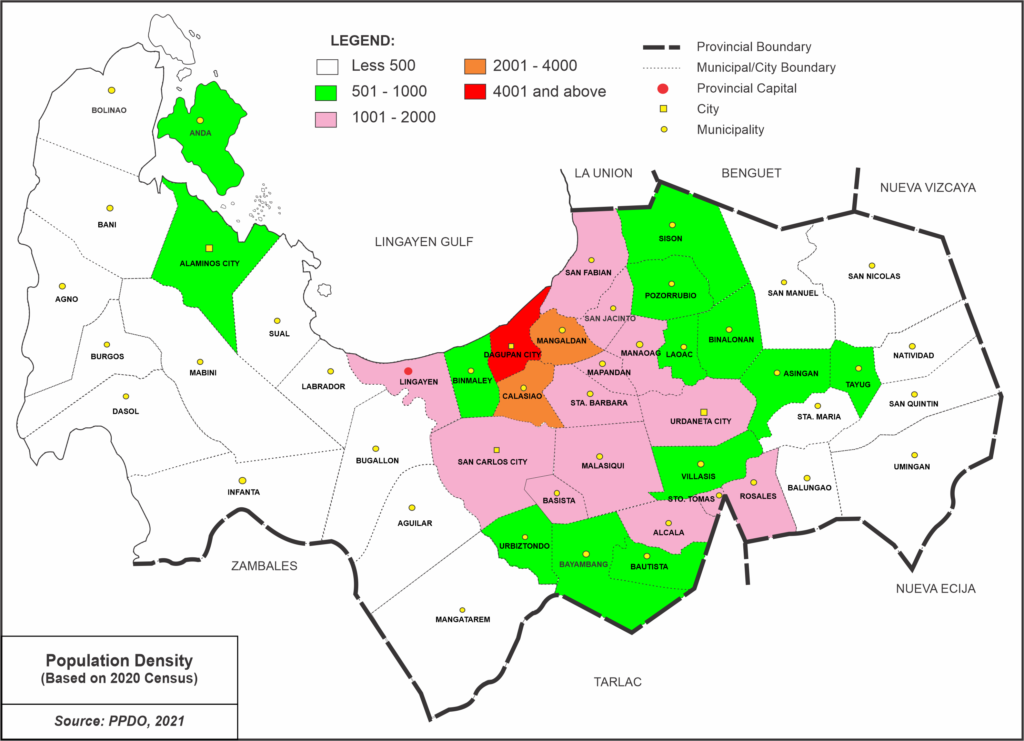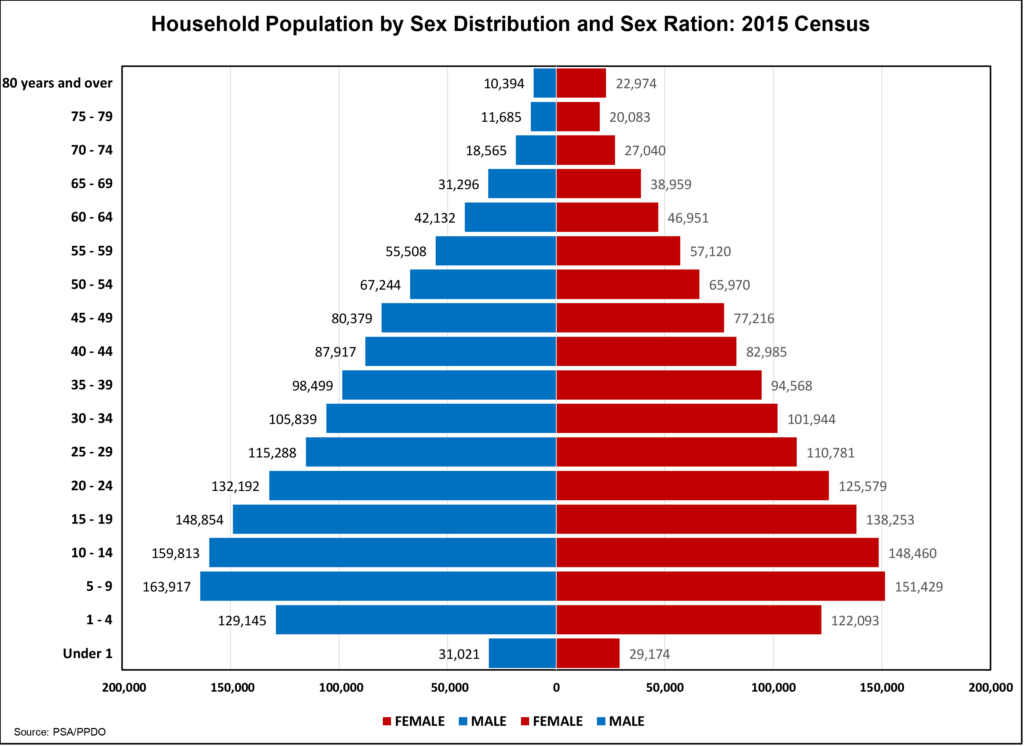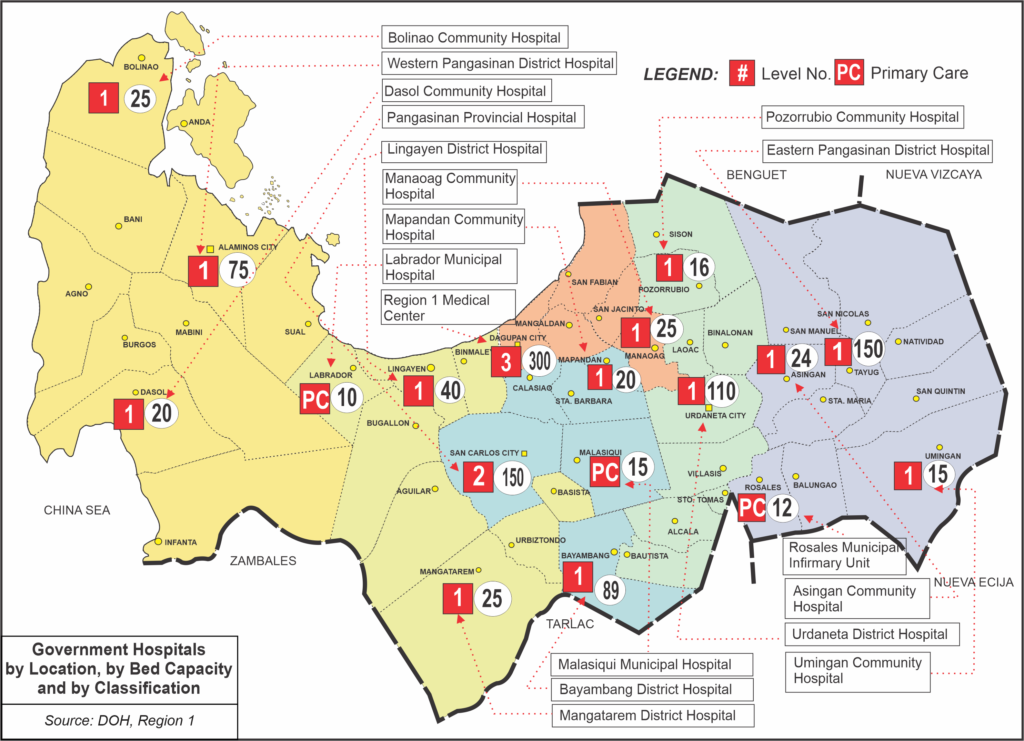Population Size, Growth Rate and Population Density
Based from the 2020 census of population, Pangasinan registered a total population of 3,163,190 and ranks sixth in the country. Compared to 2015 Census, Pangasinan was surpassed by provinces of Rizal and Cebu based on the 2020 Census. Among the four (4) cities and forty-four (44) municipalities of Pangasinan, San Carlos City had the largest population with 205,424 persons. This is followed by Dagupan City with 174,302, the City of Urdaneta with 144,577, and the municipalities of Malasiqui with 143,094 and Bayambang with 129,011 number of persons. These two municipalities exceeded the hundred thousand mark in population count higher than the population of Alaminos City of 99,397. On the other hand, the municipality of Sto. Tomas with a population of 14,878 persons, is the least populated area. In terms of growth rate (2015-2020), the province has 1.43% lower by the municipality of Labrador with 3.09. Among municipalities and cities, Labrador recorded the highest growth rate.
The projected population of the province for the year 2021 is estimated at 3,200,771 which was computed using the Geometric Method given by PSA and the 2020 Census as the base year.

The total household population (Census 2015) for both male and female is 2,951,267 wherein 1,489,688 are male and 1,461,579 are female which both gender represent 50% of the total household population. Among age groups, ages 10-14 bracket has the highest population with 308,273 while ages 75-79 is the lowest with 31,768.
In terms of sex distribution, there were more males than females in the province with a sex ratio of 102. These means that there were 102 males for every 100 female.

The province’s household population is 3,159,228 (2020 CPH) and the total number of households is 776,202 with an average household size of 4.1.
Based on the average annual growth rate of 2.71% (2015-2020), the projected number of households is 797,394, which shows an increase of 2.73% from the previous data.
Based on the 2015 Census, the province has 574 urban barangays with a population of 1,458,402 and 790 rural barangays with a population of 1,321,460. A barangay is considered urban when its population size is more than 5,000; or with at least have one establishment with a minimum of 100 employees; or with five or more establishments with 10 to 99 employees and five or more facilities within the two-kilometer radius from the barangay hall.
Health
In 2021, there were 58 public and private hospitals with a total bed capacity of 2,361. Out of this number, 1,112 beds are from government and 1,249 from private hospitals.

As per DOH data, there were 75 birthing homes established in the province. These healthcare facilities were lodged in private hospitals and Rural Health Units. From these birthing homes, Alaminos City Birthing Facility has the most number of beds.
In addition, the province had 73 City/Rural Health Units (RHUs) and 684 Barangay Health Stations (BHS) complementing health services delivery in the province.
From the different health services catered by different government hospitals, there were 90 doctors, 593 nurses, 62 dentists, 583 midwives, 19 nutritionist/dieticians and 75 medical technologists providing health care and medical treatment to various patients. This year all health personnel have increased in number.
Respiratory Disease was the most prevalent case of morbidity in the province registering 70,750 (CY 2021) cases which declined by 24.57% or 88,136 cases compared to year 2020 data. On the other hand, Heart Diseases continue to be the leading cause of mortality in the province in 2021, increased by 24.15% or 847 deaths from 3,507 total number of deaths in 2020 to 4,354 deaths for the period under review. Cerebrovascular and Pneumonia followed, claiming 3,395 and 1,943 lives respectively.
The number of livebirths went down by 14.38% from 22,620 in 2020 to 19,777 in 2021 with crude birth rate of 6.68% (per 1,000 population). Meanwhile, the number of registered deaths increased by 53.43% from 12,470 registered deaths in 2020 to 19,133 in 2021 with a crude death rate of 6.47%.
Social Welfare
Based on PSWDO data, the province has served a total of 53,478 clients on the following services: day care services; assistance to individual in crisis situation, and emergency shelter assistance.
The province had a total of 274,084 senior citizens excluding Dagupan City. Out of this number, 112,613 (41%) are males and 161,471 (59%) are females.
Education
With the continuing effect of Covid 19 pandemic, public elementary enrolment had a slight decrease from 408,217 in the previous school year (SY 2020-2021) to 405,251 this SY 2021-2022 with a minimum percentage of 0.73%. On the other hand, secondary enrolment increased by 5.8% from 227,386 to 240,582.
Pangasinan had sufficient number of public school teachers as evidenced by the teacher-pupil ratio of 1:27 for elementary and 1:26 for secondary level as against the planning standard of 1:45 for SY 2021-2022. With the pandemic, modular, online and blended classes are utilized in all schools.
As per data from the different DepEd Divisions (SY 2021-2022), the province has recorded a total of 304 government and 138 private schools teaching senior high school. From these schools, a total of 53,060 students were enrolled in government institutions while students enrolled under private schools have 26,189 (Tables 3.4.6 & 3.4.7). This means that out of the 259,510 Junior High School from public and private school last year, a total of 180,261 students did not enroll in Senior High School in the province. This may have been one of the negative effects of the pandemic in the province.
Meanwhile, data from TESDA provincial office recorded a total of 100 technical-vocational schools with a total enrolment of 15,390 for FY 2021. On the other hand, there are 14,108 graduates coming from private and public tech-voc schools. Out of the 100 tech-voc schools in the province, there are only six (6) public tech-voc schools.
Housing
There are 654,240 (2015 Census) occupied housing units in the province. Of this number, 85% are made of concrete walls with galvanized iron roofing materials.
Based from the report submitted by the Provincial Health Office in 2021, 677,156 or 98.04% of the total households have access to potable water sources while 1.96% or 13,264 households still use unsafe water sources.
On the other hand, data on sanitary toilet recorded a total of 677,156 households, of which 647,133 or 95.57% are using sanitary toilet, while some 30,023 or 4.43% still do not have sanitary toilet facilities.
Employment
This year’s employment rate of the province is 92.09%, while the unemployment rate and underemployment rate is 7.91% and 17.81% respectively. Meanwhile, the labor force participation rate of Pangasinan is 62.17%, which comprises the total employed and unemployed population.
Based from the DOLE – RO1, the daily minimum wage rate for agriculture and non-agriculture industries/sectors ranges from P282.00 to P340.00 as per Wage Order No. RB 1-20, which took effect on April 30, 2019 until further update by DOLE.
Poverty Incidence
As per Philippine Statistics Authority (PSA) survey, poverty incidence among families in Pangasinan had increased from 9.3% in 2018 Annual Poverty Incidence to 13.9% in 2021. The annual per capita poverty threshold of the province increased from P27,828 (CY 2018) to P31,240 (CY 2021) such increase in poverty incidence is due to the emergence of Covid-19 pandemic. Said survey is conducted every after 3 years.
Protective Service
The total number of PNP Officers and Police Non-Commission Officers serving the province totaled to 3,160 personnel. From this number, 2,959 are non-officers (including the non-uniform personnel) and 201 are officers. The officers include the positions of Police Colonel (formerly Police Senior Superintendent) to Police Lieutenant (formerly Inspectors). The PNP implemented the new rank classification (R.A. No. 11200) signed by President Duterte last March 25, 2019.


